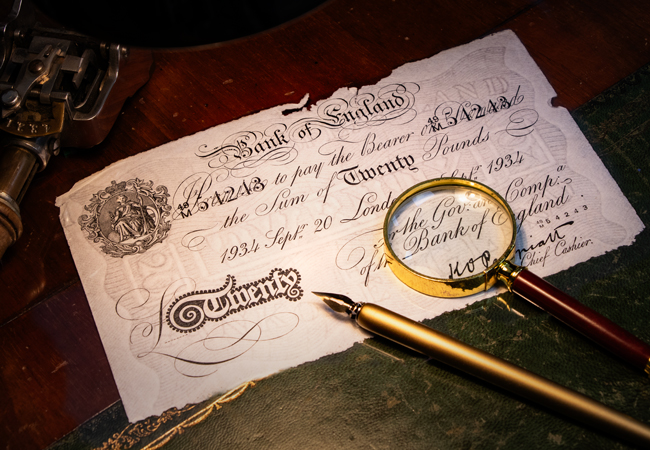Military
The Operation Bernhard Banknote – is this the most unique piece of WWII history?
Operation Bernhard was the largest counterfeiting operation in history. It was a secret Nazi plot to destabilise the British economy, in which the Germans planned to flood Europe with counterfeit notes to cause artificial inflation of the British pound.
Unsurprisingly Operation Bernhard, as it was known, is remembered as one of wartime’s most over-the-top secret plots.
Please read on to learn more about this remarkable story, and how you can be one of the few collectors to secure this surviving piece of wartime history.

The Operation
In 1942, production of counterfeit British ‘White Fivers’ began behind the gates of Sachsenhausen concentration camp. Prisoners worked to perfect the process, and by 1945 it is estimated that 70,000,000 notes were printed by inmates.
But as WWII drew closer to its end and the Nazis reached the closing months of the operation, they became concerned that their fakes notes would be exposed during trials for the war crime of counterfeiting.
In an attempt to hide the evidence, the completed notes and printing equipment were sent to Austria where they were sunk into the deepest part of Lake Toplitz.

The Recovery
In 1959, the German newsmagazine “Der Stern” financed a recovery operation to retrieve the surviving banknotes. But due to the depth of the lake, only marginal quantities were recovered.
Now, 75 years after the operation began – the notes are again in the light of day.

Your chance to secure one for a deposit of £34.50 (+p&p)
There are few WWII stories as remarkable as the one of Operation Berhnard.
And in this once-in-a-lifetime Westminster first, we are offering just 50 collectors the chance to own a genuine ‘Paper Money Guarantee’ (PMG) certified ‘Operation Bernhard’ banknote recovered from the depths of Lake Toplitz.
The last time we had 50 available, they sold-out in hours.
Don’t miss out! Click here to secure your Operation Bernhard banknote >>

The Rare Piece of WWII History Few People Know About…


As we approach the 80th anniversary of D-Day in June 2024, enthusiasts and collectors alike are eagerly seeking out military commemoratives from the era.
Amidst the rush, there exists a rare gem that only a select few are aware of, let alone possess.
It is the Hawaii Overprint Emergency Banknote issued between 1942-1944, and The Westminster Collection have a handful available today – flown to the UK straight from Hawaii.
Read on to learn the fascinating story, what makes them so scarce, and how you can secure one.
USA – World War Two
During the tumultuous years of World War II, the United States government found itself in a precarious position following the devastating attack on Pearl Harbor.
With deep concerns looming over the possibility of a full-scale invasion of Hawaii by Japan, urgent measures were needed to safeguard the American economy from potential exploitation.

To counter this threat, the US government took swift action, issuing emergency banknotes specifically for use in Hawaii. These $1 Silver certificates bore distinct markings, featuring a brown seal and prominent “HAWAII” overprints on both the front and back.
This unique design served a crucial purpose: in the event the notes were seized by enemy forces, they could be repudiated, rendering them worthless thus spoiling attempts at economic sabotage.
A Rare Piece of Military History
Issued only for two years between 1942 and 1944, these emergency banknotes are exceptionally rare, with very few surviving examples still in existence today.
Their scarcity means they rarely make appearances on the secondary market, making them highly sought-after among collectors and historians alike.

Less than 25 Available
Here at The Westminster Collection, we have managed to secure a limited number of these extraordinary artefacts.
In fact, there are less than 25 available for collectors in the UK, travelling all the way over from the States.
This represents a rare opportunity to own a piece of history that encapsulates the resilience and ingenuity of a nation during one of its darkest hours.

How to Secure Yours…
These WWII emergency banknotes offer a tangible connection to the past, serving as a poignant reminder of the unwavering spirit that prevailed during a time of global upheaval.
Don’t miss your chance to own a piece of this remarkable history.
Striking a coin for his father: The ‘Mad’ Piper of D-Day
John Millin honours his father, Piper Bill Millin, in a poignant tribute by striking a 50p coin for the 80th Anniversary of D-Day.
Stay tuned for the full exclusive interview coming TUESDAY.
